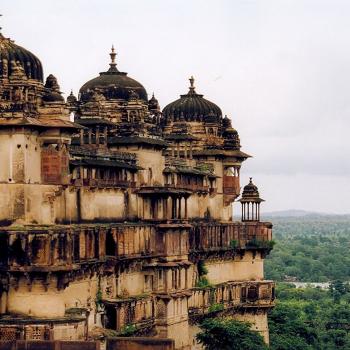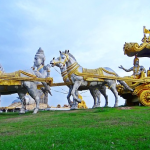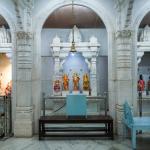Reproduced with permission from All About Bharat.
An exploration of the history, legends, architecture and travel information of the Konark Sun Temple, in Orissa, India, a UNESCO World Heritage Site.
The Sun Temple of Konark stands at the end of a deserted stretch of coast in Odisha, at the Bay of Bengal. Sailors of yore used this temple as a navigational aid for centuries. It was known as the “Black Pagoda,” which distinguished it from the “White Pagoda” – the Jagannath Temple 32 kilometers further up the coast at Puri. Though the Sun Temple stands nearly three kilometers from the ocean today, when it was built 800 years ago, it stood at the very edge of the sea. There is something raw about the entire ambience of the place. Storms and sea winds batter its stone walls and salt and sand cut away and erode it as the temple appears to be gradually melting away into the sand.
Sun worship is very significant to Indians. The standard daily prayer of brahmins is the Gayatri mantra, addressed to the sun. The practice of Surya Namaskar or Sun Salutation is also an important part of yogic practice.
The Legend
Historians have been unable to unearth any clear reason as to why a temple was erected here, but many legends have come up to fill this gap. The most popular one tells the tale of Krishna’s son, Samba, who was too proud of his beauty. So proud in fact, that he once made fun of sage Narada, a person who was not all that good looking. Narada plotted his revenge and lured Samba into a pool where his stepmothers were bathing in joyful abandon. When it came to Krishna’s notice that his son was misbehaving with his wives, he cursed him with leprosy. Realizing later that the innocent boy had been tricked by Narada’s cunning, Krishna was mortified. But he could not revoke his curse. All he could do was advise his son to worship the sun god Surya, healer of all diseases, and hope for a cure. After twelve years of penance and worship, Samba was at last instructed by Surya to go and bathe in the sea at Konark. He did so and was cured of his awful affliction. Samba was so delighted that he decided there and then to erect a Surya temple on the spot. It was called Konarka, “Place of the Sun,” from which the modern name comes.
The History
Historical fact has always been interwoven with myth in India, and there may be an interesting connection here. We know that the temple was actually built by a king of the medieval Ganga dynasty, Narasingha Deva (1238-1264). The king was popularly known as langulia, “the one with a tail.” One explanation is that Narasingha built the temple to commemorate his victories over the Muslims, who were pushing into Odisha from the west. We know that during his reign he won at least three resounding victories over the invaders.
By the end of the sixteenth century, Konark was famous far beyond the borders of Odisha and had become a great center of pilgrimage and attracted the praise of even such a discriminating critic as Abul Fazl, the court biographer of Akbar. He tells us: “Near Jagannath (Puri) is a temple dedicated to the sun. Its cost was defrayed by twelve years’ revenue of the province. Even those whose judgment is critical, stand astonished at the sight. 28 temples stand in its vicinity; six before the entrance and 22 within the enclosure, each of which has its separate legend.”
Those days are gone. All that now remains is half the main temple, and even that is damaged. Nevertheless, this mere fragment of Konark’s former glory constitutes what is often considered to be the most impressive temple in northern India.
The story is told that Narasingha Deva was delighted with the achievement of his craftsmen. One day, the king decided to see how the building of the Sun Temple was progressing. He disguised himself and wandered about the site, incognito, looking here and there to see that the work was to his satisfaction. In one corner of the vast camp he came across a famous craftsman, absorbed in carving out a block of stone. This artist had an attendant, a young apprentice whose sole job was to squat behind the master and supply him with refreshment whenever he needed it. This refreshment was in the form of pan-betel leaf wrapped around a bitter and heady mixture of chopped areca nut, chewing tobacco, and lime.
The king motioned to the attendant to move, and silently took his place. So absorbed was the master, that he did not notice anything had happened behind him. After a while, he stretched back his hand for more pan. The king, who had been gazing entranced at the beautiful work being done, quickly got out his own pan box of finest silver, took out a bundled leaf, and put it in the outstretched hand. The craftsman popped the pan in his mouth and went on working. For a few moments nothing happened, but then he suddenly realized that the pan he was chewing was of a far higher quality than normal. Turning around to find out what was going on, he recognized the face of his king. Spluttering profuse apologies, the sculptor prostrated himself before the squatting monarch. But Narasingha Deva would have none of it. Rising to his feet, he lifted up the artisan and then bowed down low before him, saying: “Maharaj! You are so talented, you are indeed worthy to have the king as your attendant!”
It is said that gigantic magnets within the temple ensured that the metallic deity of Surya remained suspended in midair. However, when Muslim armies threatened the kingdom a few centuries after it was built, the local maharaja removed the cult image of Surya from the sanctuary and it was taken to Puri for safety. Once the Muslim armies invaded, the place fell into total neglect.
The decay was gradual. Even in 1848, a corner of the tower still stood to a considerable height. In 1820 this was about 35 meters according to the Scots traveler A. Stirling who saw it then. The English architect Markham Kittoe, writing in 1838, estimated it had diminished to “80 or 100 feet, and has at a distance the appearance of a crooked column.” But this brave remnant was not to last long. Ten years later, in 1848, it was blown down in a ferocious gale. When the Indian writer Rajendralala Mitra visited the site after another twenty years, even the sanctuary over which the proud shikhara had towered was reduced to “an enormous mass of stones, studded with a few pipal trees here and there.” The porch – that part of the temple still standing – suffered more from the hands of man than from the elements. The chief villain of the piece was a Raja of Kurda, who took a particular liking to the chlorite slabs that decorated the facade of the building. Again, on-the-spot evidence comes from Kittoe.
“The Kurda Raja has demolished all three entrances and is removing the stones to Puri; the masons pick out the figures and throw them down to take their chances of being broken which most of them are. These they leave on the spot; those that escape uninjured are taken away. Nor were the local people averse to helping themselves to the iron clamps, for the sake of the metal.”
Fortunately, this vandalism was stopped by order of the government in 1838. The story of the conservation and repair of the temple has become an inextricable part of its myth. Sadly, the early part of the story is a classic tale of bureaucratic bungling. The first suggestion to repair the ruin came from the unlikely direction of the Marine Board. In 1806 they submitted a proposal to have the temple repaired so that it could once more be a useful navigational landmark for the ships in the Bay of Bengal! But the government considered the expense involved to be too great.
This was again the reason given by the deputy governor of Bengal in 1838, when he refused to do anything to preserve the temple. In 1882-83, some jungle clearance was undertaken and a few statues mounted on platforms around the site, but in the wrong place. In 1892, Lieutenant Governor Sir Charles Elliot refused to grant any money for restoration, though some individual pieces of sculpture were shifted to the Calcutta Museum a couple of years later. Elliot did suggest that some debris be cleared from the rear of the porch, but this was not done, because the superintendent engineer thought that such action would weaken what remained of the building. Thus a hundred years were wasted before any constructive action was taken to improve the site. In 1900 Sir John Woodburn, the new lieutenant governor, visited Konark and immediately issued an order that repair and restoration should begin without further delay.
Periodic renovations took place well into the twentieth century. The latest survey was by an international team from UNESCO who, in 1980 produced the extraordinary suggestion that the entire temple should be covered in a coat of fiberglass to protect it from the march of time.















